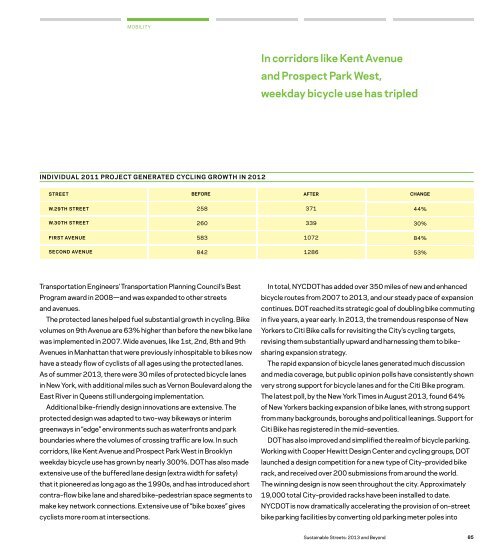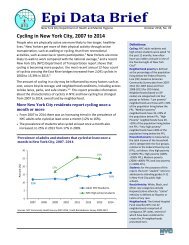2013-dot-sustainable-streets-lowres
2013-dot-sustainable-streets-lowres
2013-dot-sustainable-streets-lowres
You also want an ePaper? Increase the reach of your titles
YUMPU automatically turns print PDFs into web optimized ePapers that Google loves.
MOBILITYIn corridors like Kent Avenueand Prospect Park West,weekday bicycle use has tripledINDIVIDUAL 2011 PROJECT GENERATED CYCLING GROWTH IN 2012STREETBEFOREAFTERCHANGEW.29TH STREET25837144%W.30TH STREET26033930%FIRST AVENUE583107284%SECOND AVENUE842128653%Transportation Engineers’ Transportation Planning Council’s BestProgram award in 2008—and was expanded to other <strong>streets</strong>and avenues.The protected lanes helped fuel substantial growth in cycling. Bikevolumes on 9th Avenue are 63% higher than before the new bike lanewas implemented in 2007. Wide avenues, like 1st, 2nd, 8th and 9thAvenues in Manhattan that were previously inhospitable to bikes nowhave a steady flow of cyclists of all ages using the protected lanes.As of summer <strong>2013</strong>, there were 30 miles of protected bicycle lanesin New York, with additional miles such as Vernon Boulevard along theEast River in Queens still undergoing implementation.Additional bike–friendly design innovations are extensive. Theprotected design was adapted to two–way bikeways or interimgreenways in “edge” environments such as waterfronts and parkboundaries where the volumes of crossing traffic are low. In suchcorridors, like Kent Avenue and Prospect Park West in Brooklynweekday bicycle use has grown by nearly 300%. DOT has also madeextensive use of the buffered lane design (extra width for safety)that it pioneered as long ago as the 1990s, and has introduced shortcontra–flow bike lane and shared bike–pedestrian space segments tomake key network connections. Extensive use of “bike boxes” givescyclists more room at intersections.In total, NYCDOT has added over 350 miles of new and enhancedbicycle routes from 2007 to <strong>2013</strong>, and our steady pace of expansioncontinues. DOT reached its strategic goal of doubling bike commutingin five years, a year early. In <strong>2013</strong>, the tremendous response of NewYorkers to Citi Bike calls for revisiting the City’s cycling targets,revising them substantially upward and harnessing them to bike–sharing expansion strategy.The rapid expansion of bicycle lanes generated much discussionand media coverage, but public opinion polls have consistently shownvery strong support for bicycle lanes and for the Citi Bike program.The latest poll, by the New York Times in August <strong>2013</strong>, found 64%of New Yorkers backing expansion of bike lanes, with strong supportfrom many backgrounds, boroughs and political leanings. Support forCiti Bike has registered in the mid–seventies.DOT has also improved and simplified the realm of bicycle parking.Working with Cooper Hewitt Design Center and cycling groups, DOTlaunched a design competition for a new type of City–provided bikerack, and received over 200 submissions from around the world.The winning design is now seen throughout the city. Approximately19,000 total City–provided racks have been installed to date.NYCDOT is now dramatically accelerating the provision of on–streetbike parking facilities by converting old parking meter poles intoSustainable Streets: <strong>2013</strong> and Beyond85



